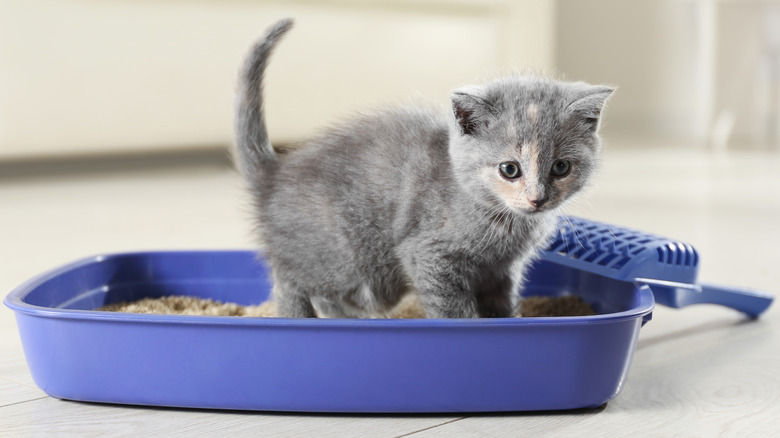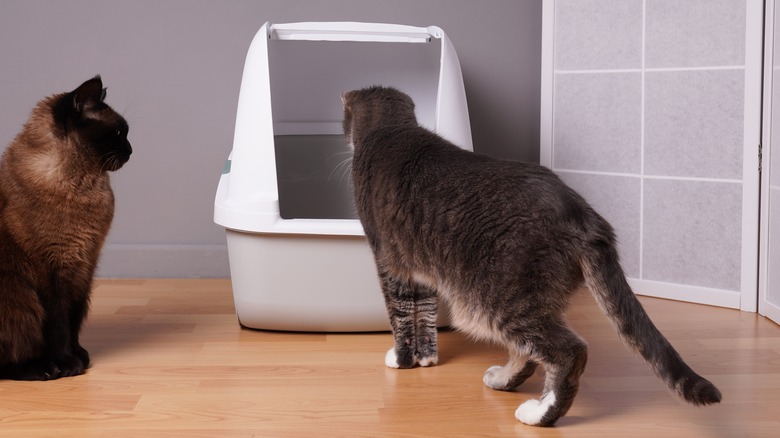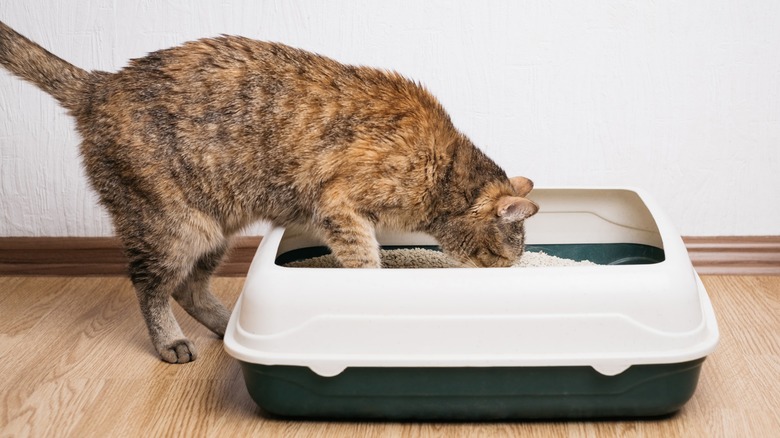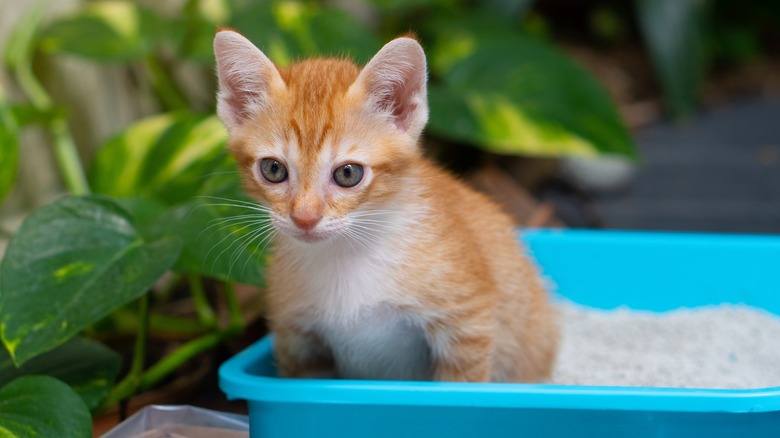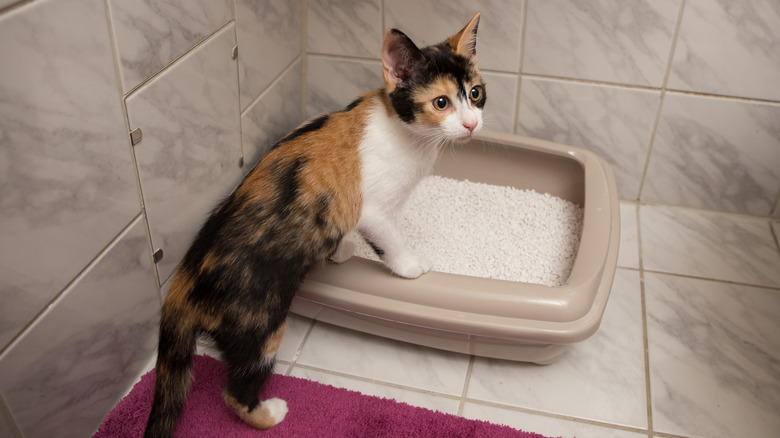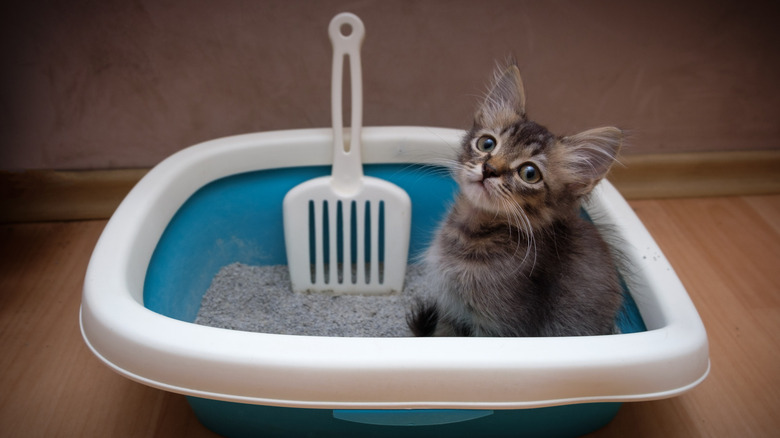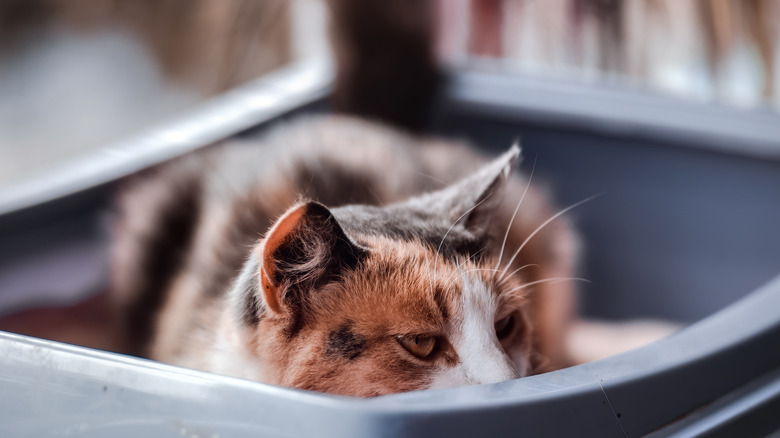The Best Places To Put A Litter Box In Your Home
More than 31 million American households are home to at least one cat (per WorldAtlas), making cats second only to dogs in terms of popularity. Even though cats are naturally fastidious creatures — it's a survival instinct for them to hide their urine and feces, so as not to attract predators — what's never popular with cat owners is dealing with litter boxes.
Jackson Galaxy, host of "My Cat From Hell" on Animal Planet, is an expert on cat behavior. "There are really two litter box users: your cat and you. Your cat uses the box for her business but you are responsible for cleaning it. That means the area needs to function for both of you," Galaxy and Kate Benjamin wrote in "Catify to Satisfy: Simple Solutions for Creating a Cat-Friendly Home."
The questions regarding litter boxes can be confusing for anyone welcoming a cat into the household for the first time. Covered or open? Big or small? Self-cleaning or traditional? Filled with litter made from clay or corn, shredded newspaper, or gel crystals? How to get rid of the litter odor? When to throw the litter away? Is it safe to scoop kitty litter while pregnant?
But what usually causes the most strife is deciding on a location. As with real estate, when it comes to litter boxes, the key is location, location, location.
How many litter boxes should you have?
The first step regarding litter box placement is deciding how many boxes are required in your home. The recommended minimum is the number of cats plus one. This means two cats need at least three boxes, while three cats require at least four boxes. Even in a household with just one cat, two litter boxes is the suggested minimum.
"Many cats prefer to poop in one and pee in the other — it's instinctual to not leave all their waste in the same place," feline training and behavior specialist Bridget Lehet told PetMD.
It's also a smart strategy to have multiple boxes so that if your finicky feline takes a dislike to one box for whatever reason, or if one box is temporarily blocked by a barking dog or a noisy child, there is always another one available. In a multilevel house or townhome, there should be at least one litter box on each level, so that cats always have easy access whenever nature calls. This becomes even more crucial with very young and very old cats.
To avoid the territorial policing and even bullying that can sometimes happen in a multi-cat household, multiple litter boxes should be placed in various locations around the home, not side by side in a single spot.
The basement, garage, attic, or laundry room shouldn't be the first option for a litter box
Many people dislike the concept of a litter box so much that they tuck it out of sight in a basement, garage, attic, or laundry room, but these rooms are often left dark. "If you lived in a home where the only toilet you could use was in a dark corner, you would not want to go there," cat behavior specialist Paula Garber said to PetMD. Similarly, cats feel safer and more secure in a well-lit area. Cats also prefer areas without a strong smell. These rooms often have the pungent odors of cleaning products or solvents.
Additionally, appliances that are noisy or vibrate — such as washers and dryers — can startle a cat. An attic can be stifling hot in the summer, which exacerbates smells coming from the litter box, while a garage or basement can be uncomfortably cold for a cat.
"A box that is in a basement can be a problem for an older cat that has trouble with stairs or their eyesight," Dr. Cathy Lund, of the feline-only veterinary practice City Kitty, explained to PetMD.
Put the litter box somewhere the cat likes to spend time
Though many people balk at the idea, the best location for a litter box may be the bedroom, living room, kitchen, or dining room. "I'd rather have a litter box in my bedroom than a cat peeing on my carpet," Pam Johnson-Bennett, owner of Cat Behavior Associates, told PetMD.
Of using these common locations, Jackson Galaxy further explained to Catster, "You have to get over 'litter box as enemy.' These are the concessions you make when you consider the beautiful results of having a relationship with a cat."
Galaxy often stresses the importance of what he calls scent soakers: signposts such as soft beds, cat trees, scratching posts, and litter boxes, where cats can detect their own odor. Scent soakers reassure cats that they're safe in their own territory.
"Now the litter box is the king of all scent soakers. That is where they mark; it's not just a place to eliminate — it's a place for your cat to identify a key part of her ownership of this territory," he explained to Modern Cat. "Make sure that your litter boxes are not just scent soakers but that there is enough of them to be signposts throughout the socially significant parts of the house." The bedroom and living room are socially significant — the attic and basement usually are not.
Still unsure about a litter box in the living room? Flip through "Catify to Satisfy: Simple Solutions for Creating a Cat-Friendly Home" to see photos of a dresser, end table, trunk, antique chicken coop, and more, each repurposed to hold a litter box.
Put the litter box somewhere private and quiet
Humans prefer privacy while attending to nature's call, and some cats are the same. A spacious, well-lit bathroom may be the perfect location for a litter box, especially if the box can be positioned so that the cat can easily see when people or other animals are approaching and can have multiple exit points. Cats don't like to feel trapped or cornered.
The ideal place is somewhere quiet, far removed from constant movement and doors slamming. "Generally you want litter boxes that are out of traffic but not at the end of a scary, trappable tunnel," Dr. Neil Marrinan of Old Lyme Veterinary Hospital told PetMD. Choose somewhere that is also far away from food dishes and water bowls, since cats don't like to eat and defecate in the same area.
If dogs or small children won't leave the litter box alone, try placing it behind a baby gate that your cat can easily jump over or slip under, or install a cat door on a bathroom or spare room. If other household cats are causing litter box access problems for one cat, consider installing a radio-controlled cat door that only the one cat can open.
Put the litter box somewhere convenient
With all of this in mind, the litter box needs to be convenient for your cat, or else they won't use it. "Check out where your cat spends the most time," feline behavior counselor Blair de Jong said to PetMD. "If your cat never goes up to that weird attic room, don't put the litter box up there."
The location also needs to be convenient for you, or else you won't scoop it regularly. Cats are fussy about the cleanliness of their boxes, and most will stop using a dirty box. Scooping regularly is important not just for sanitary reasons but also for monitoring your cat's health. Self-cleaning litter boxes can be problematic for precisely this reason.
"So when you have zero evidence and therefore zero information about your cat's waste, you have a massive gap in knowledge about his general health," Jackson Galaxy and Kate Benjamin wrote in "Catify to Satisfy: Simple Solutions for Creating a Cat-Friendly Home." "Remember, cats are remarkably stoic about pain, programmed to hide weakness from predators. They will not give you demonstrative signs of discomfort. Rather, you have to find those signs. And with these types of litter boxes, those signs are, literally and figuratively, flushed away."
A litter box should be placed in an uncarpeted area, where it's easy to clean up accidents and sweep up stray litter. And if your cat constantly soils a specific spot where there is no litter box, try putting one there. The cat is sending a clear signal about their preferences.
Dealing with litter box problems
If your cat urinates or defecates outside the litter box, hesitates before entering the box, or leaps out of the box as soon as possible and gallops away as if being chased, the first step should be a visit to the vet. A medical condition such as a urinary tract infection, inflamed bladder, kidney disease, or arthritis could be causing the change in behavior.
"Any cat who suddenly starts missing the litter box — especially if they've always been good about it before — needs to immediately go to the veterinarian," cat behavior consultant Trish McMillan Loehr emphasized to PetMD.
If your kitty gets a clean bill of health, then you need to play detective and analyze everything: type of litter (did you switch brands?), cleanliness of litter (are you scooping less often?), size of litter box (is something bigger needed?), number of boxes (is an extra one required?), box's location (did you move the box?), etc.
Keep in mind that a litter box location that used to be acceptable to your finicky feline could now be tainted after a scare or other unpleasant incident. The key is really to pay attention to what your cat may be trying to communicate to you, then act accordingly.
